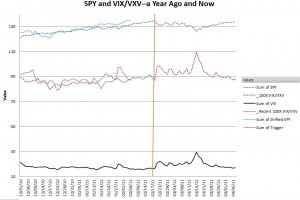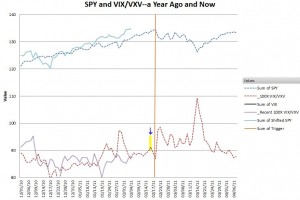If you can remember market action for more than two months, you’re probably not wondering: “Is Market Volatility Gone for Good?” However you probably are wondering when this sustained upswing will be over. I’m keeping a close eye on things because I’ve had a run-up in my VelocityShares XIV holdings that I’d rather not lose to a correction.
The last few months have felt like the market a year ago, when the market had a sustained climb. The chart below confirms that SPY is following a similar path—the dotted lines are last year’s data. The orange vertical line marks when the market shifted into a choppy sideways phase last year.
Predicting a market change is notoriously hard. Since it is driven by options premiums, and options traders are theoretically more sophisticated than standard equity investors you might expect the VIX index to move before the market—but it doesn’t. The chart below shows how the VIX bump (black line at bottom) lagged the the 18-Feb-2011 market shift by a couple of days.

The trace around 90 shows the VIX/VXV ratio multiplied by 100. The VXV is a CBOE index similar to the VIX that projects volatility out 3 months instead of the VIX’s 1 month time frame. A magnified version of the chart is shown below:

The VIX/VXV ratio shows an interesting little bump above 0.9 just a few days before the correction. The VIX index moved up slightly on those two days—it’s not readily apparent on the VIX chart, but the VXV didn’t move up as much, and as a result the ratio bumped up. The bright folks at Barclays use this VIX/VXV ratio as the master control for allocating volatility assets in their XVZ volatility ETN. When the ratio climbs to 0.90 or above they decrease their allocation into short volatility.
The chart shows that the VIX/VXV ratio rose above 0.9 several times in 2011 before the correction—false alarms. However those bumps were accompanied by relatively big moves in the VIX index. It could be that the VIX/VXV ratio bumps that aren’t associated with significant overall jumps in volatility might be the signals to really watch.
I fully expect the VIX/VXV ratio to sound some false alarms in the future, but when it says the risk is low, with levels below 0.9, I’m inclined to relax.
The market closed today with a VIX/VXV ratio of 0.878—I guess I’ll hold inverse volatility a bit longer.

Click here to leave a comment